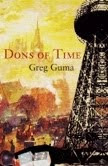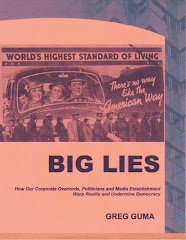Audio recorded at a live performance in Burlington, Vermont.
Dissent and Its Enemies
Inquisitions (and Other Un-American Activities) uses the interrogation of activist Lucy Parsons during the 1919 Palmer raids as a framework. Available for radio and stasge production, the play — featuring more than 20 speaking roles, drama, comedy, and historical recreations — explores timely themes through dramatic recreations of the movement for an eight-hour workday, the Haymarket bombing, and the show trial of four activists. It is based on more than a decade of research, and includes characters like radical organizer Albert Parsons, tycoons Marshall Field and John D. Rockefeller, muckraker Henry Demarest Lloyd and J. Edgar Hoover at the start of his FBI career.
Since 2003, Inquisitions... has aired on dozens of stations in more than 20 US states. The complete running time is two-hours. It can be abridged, aired in installments, or restaged with permission. The original stage production was written by Greg Guma, directed by Bill Boardman, and co-produced by Toward Freedom and Catalyst Theatre Company
Click here to listen to an audio excerpt in RealAudio (7 min.)
Click here to listen to an audio excerpt in MP3 (7 min.)
Inquisitions... is available as a free download for noncommercial radio stations. Contact Squeaky Wheel Productions to register and download at: betweenthelines@snet.net or call (203) 268-8446. Print copies of the script: $25; email mavmedia@aol.com.
Podcast Series
Listen to "Inquisitions — An Audio Drama — Act 1" on Spreaker.
With the FBI interrogation of activist Lucy Parsons in 1919 at its center, Act 1 of the podcast version takes listeners back to the birth of the movement for an eight-hour workday and the resulting violence in May 1886.
Act 2 recreates the post-Haymarket show trial of eight German activists. The interrogation of Lucy Parsons continues — by a young J. Edgar Hoover — as she defends her controversial life.
In Act 3, the trial concludes as capitalist oligarchs celebrate on a surrealistic dream train. Before her interrogation ends Lucy Parsons remembers her fight for clemency and the unjust hanging of her husband and comrades. Written by Greg Guma, directed by Bill Boardman, and produced by Catalyst Theatre.
Theater Review excerpts
Back in 1963, before Greg Guma made his mark as a Vermont journalist and political activist, he was honing his rhetorical skills in high school, winning dramatic interpretative contests with his delivery of Atticus Finch's closing statement to the jury from To Kill a Mockingbird. Something about the speech "resonated" with the young Guma. "It was about civil rights," he says. "Frankly, in my Catholic high school we didn't learn much about that."
Atticus' eloquent defense of a black man wrongly accused of raping a white woman is indeed a resonant piece of writing, one that made an impression first in Harper Lee's Pulitzer Prize-winning novel and then, even more indelibly, in the 1962 film version with Gregory Peck, who won an Oscar for his performance as the small-town Alabama lawyer and widowed father of two.
This month, local audiences get the chance to revisit that famous speech and the other charms of Mockingbird in a stage adaptation by Vermont Stage Company. And coincidentally, this past weekend at Burlington City Hall, under the auspices of the Catalyst Theatre Company, Greg Guma premiered a play with its own share of courtroom drama: Inquisitions (and Other Un-American Activities) is an epic examination of labor unrest in late 19th- and early 20th-century America.
VSC's Mockingbird reminds us why Lee's story has remained so beloved, without, however, succeeding completely as a work of theater. Guma's play is clearly a work in progress, but it benefits from an ingenious radio-drama approach that shows how much can be communicated by crafty direction, a versatile cast and a few well-chosen sound effects...
Greg Guma's Inquisitions may send you running back to your history books. Editor of the Burlington-based progressive newsletter Toward Freedom, Guma has spent years researching the events in his historical drama, the Haymarket bombing in 1886 Chicago and the Red Scare of 1919. Not surprisingly, then, one problem with the play in its current stage of development is that there's perhaps too much history and not enough drama, an overload of archival oratory and a multitude of characters and events.
That said, the script has great potential, particularly in its focus on one fascinating character, and director Bill Boardman, known for his work with the Panther Players on radio and CD, found numerous inventive ways to tell the story through the convention of a script-in-hand radio drama.
A brief historical refresher: On May 4, 1886, during a labor protest in Chicago's Haymarket area, someone in the crowd threw a bomb which killed seven police officers. Political radicals were arrested by the dozens as a result, and eight of the most visible were brought to trial and convicted of murder even though there was virtually no evidence of their involvement. Four of those men were hung, and one killed himself in prison.
Bombings alleged to be the work of anarchists were also a key factor in the Red Scare of 1919 and the raids led by Attorney General A. Mitchell Palmer. Fanning the flames of xenophobia already stirred by WWI, Palmer used the bombings as an excuse to go after "reds" of all stripes, particularly if they were foreign-born, and he deported 249 resident aliens. Palmer's recruitment of a young John Edgar Hoover from the Library of Congress to help with the investigations laid the groundwork for Hoover's FBI.
These summaries don't begin to name all the colorful characters involved, but most of them show up in the Haymarket sections of Guma's play -- everyone from department store mogul Marshall Field to muckraking journalist Henry Demarest Lloyd to the accused anarchists. Guma makes one character the focus of the action, and luckily she's the most interesting: Lucy Parsons, the African-American wife of firebrand anarchist orator Albert Parsons, one of the four men executed. An equal partner of Albert's both in marriage and in activism, Lucy led the unsuccessful fight to free her husband and continued speaking out after his death.
The play begins with a 66-year-old Lucy under interrogation by a federal agent on Nov. 11, 1919, the anniversary of her husband's death. She's been picked up as part of the Palmer Raids. Guma has no hard evidence that she was interrogated at that time, but it's a fair assumption. And the device of the interview allows for segues into Haymarket flashbacks while also providing, in the older Lucy, an enjoyable protagonist.
Two actresses, Sandra Gartner and Sheila Collins, did excellent work portraying Lucy in her older and younger years, respectively, with Gartner particularly effective in capturing both the sass and the sadness of the character.
However, the play returns too often to the interrogation motif, and when J. Edgar himself steps in to harangue Lucy, he's so broadly written that it's like watching two opposing mouthpieces, not an interaction between real human beings. Only when he takes the questioning to uncomfortably personal places -- asking about Lucy's son, a Spanish-American War vet whom she committed to a mental institution -- do we get into more interesting territory. There are still-untapped possibilities to explore in the character of Lucy, and Guma would do well to pull back on some of the political rhetoric and go deeper into the personal details.
A number of other characters capture our attention because of their particular quirks or multiple dimensions. Socialist newspaper editor and Haymarket defendant August Spies is equally contemptuous of Marxism and capitalism; Ruth Wallman, in a nice example of gender-blind casting, was humorously flinty in the role. Roger Dodge made the most of his moments as the grandstanding prosecutor. Wayne Martens underplayed nicely as both uber-detective Alan Pinkerton and defense attorney "Captain" Black.
Throughout, the ensemble was effective in establishing context, whether as cheering crowds or carousing barflies, and Boardman consistently made astute staging choices. Special credit to light and sound designers Brad Butler and Steve Osterlund, whose contributions made a real case for the potential of the script as a radio drama.
Whatever happens to Inquisitions, it's inarguably timely now, as the contradictory demands of national security and civil liberties are once more at odds. Toward the end of the play Lucy says, "We're all so fragile. How can we make a government that isn't?" I asked Guma the same question in an interview after the performance. His response: "We can try." In recasting historical events in a form that can illuminate these questions, he's making an effort that's worthy of further attention.
—David Warner, May 7, 2003, Seven Days
Background
Unions are often portrayed as just another corrupt special interest group. But the true, largely ignored history of the labor movement tells a very different story: a long and dedicated effort, despite ruthless opposition, to shorten working hours, obtain a living wage, and win reforms like Social Security. Here is a six part series that puts labor’s historic struggles and contemporary challenges into context.






























